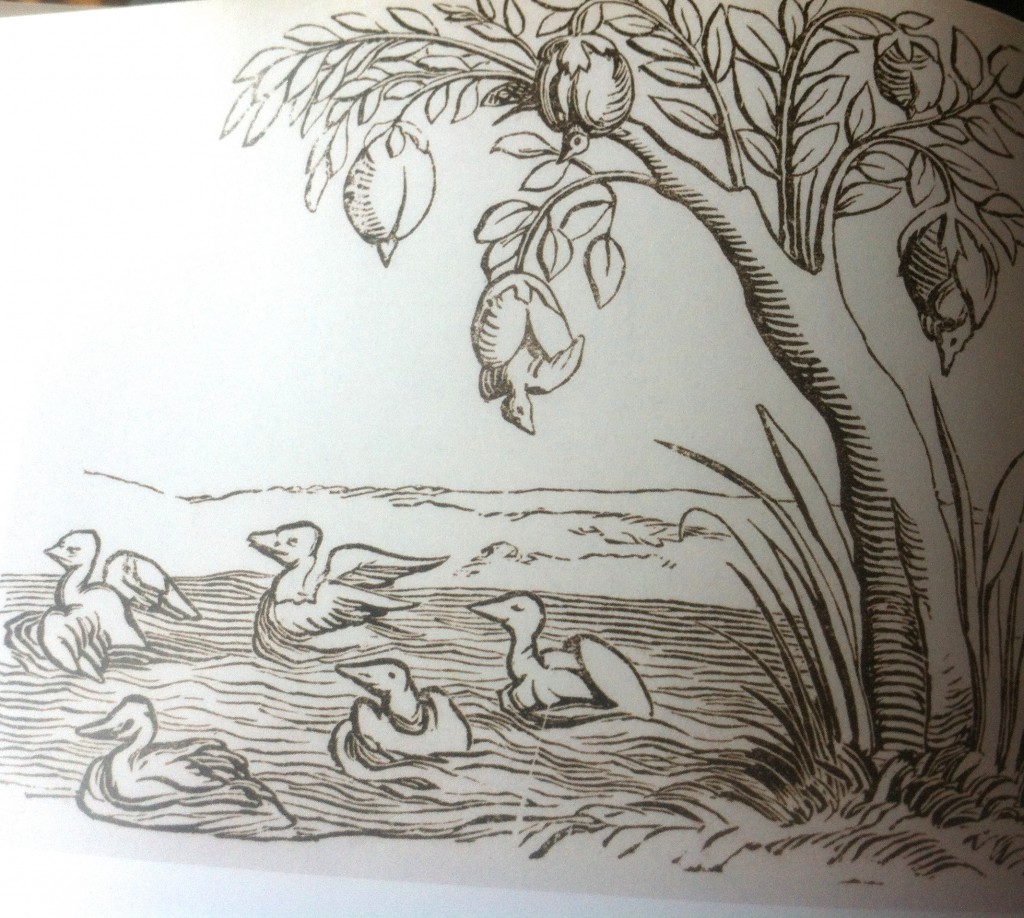For centuries, people have realized that birds, animals, even insects will appear and disappear during different times of the year. But where do those creatures go? And how do they come back the next year, alive and well?
Some of the early theories are just too great not to share.

Woodcut of Barnacle Geese circa 1552
One idea from the 1500s maintained that Barnacle Geese were spawned by trees overhanging the water’s edge, where they dangled from the branches by the tips of their bills. They would fall into the water, and spend the winter in the form of barnacles, attached to rocks and piers, then rise up out of the water as geese again in the spring. Look at their happy little faces. Made it through another winter!
Another theory, proposed by Aristotle, was that birds were capable of transmutation- in other words, one species was able to turn into another species of bird at certain times of year. His beliefs were strengthened further when he saw birds in mid- moult, when their feathers were moulting and they were trading their brighter breeding plumage for a more subtle winter look. This theory of transmutation persisted in the scientific community for many years.

1555 Woodcut Showing fishermen retrieving a net full of hibernating swallows.
Olas Magnus, a 16th century naturalist, described how swallows hibernated under the sea in the winter. The woodcut print above depicts the swallows being retrieved from the depths, most likely to be eaten.
Other scholars believed that the swallows lost all their feathers and hid naked in holes in trees and in rocks for the winter. Sounds cozy.
Throughout human history, we have tried to explain the world around us, and we haven’t always gotten it right. So even though we might chuckle at some of the early theories about seasonal movements of birds, we have to admit we still don’t have all the answers.
Even modern day scientists cannot fully explain the migration of birds. Each answer just begs another question, and humans are still figuring it all out. The migration of birds remains one of the most fascinating phenomena in the natural world.
To find out what birds are migrating through the Quinte region, you can read Terry Sprague’s daily Quinte Area Bird Report.
Ah, the beautiful monarch butterfly. It migrates too! Imagine such a delicate creature fluttering its way all the way to Mexico.
I did not realize until recently that we have only known about the now-famous monarch butterfly wintering grounds in Mexico since the 1970s. Before that, researchers knew they had seasonal movement, but were not sure where they went to spend the winter.
Earlier this month, I had the pleasure of meeting Audrey Wilson, a local naturalist and educator, who was one of the volunteers who helped with the research into monarch butterfly migration. She worked with a scientist from the University of Toronto, Fred Urquhart, who studied the seasonal movements of monarch butterflies for over 40 years.
Countless monarch butterflies received wing tags. These tags carried identification codes, and the words “Send to Zoology University Toronto Canada.” It was hoped that when people found these tagged butterflies in different parts of the continent, they would return them to Toronto, and the movements of the butterflies could be tracked. It took years, but the pieces of the puzzle all started to come together in the early 1970s, after Fred’s wife Norah had written some newspapers in Mexico asking for people to report sightings and help with tagging. A researcher from Mexico City, Kenneth C. Brugger, responded to the Urquharts and was the one who eventually located the colony of overwintering monarchs in the mountains of the Sierra Madre in Mexico.
Look at this photograph! Amazing. The feature article of National Geographic magazine in August 1976 describes the details and the excitement that went along with the research and the discovery of the monarch butterflies wintering grounds in Mexico. I cannot imagine how gratifying it was for Fred Urquhart and his wife Norah to finally be able to visit the colony, the location of which had been a mystery to them for most of their lives.
Read the article here: Found at Last- The Monarch’s Winter Home
Humans have put together many pieces of the migration puzzle, but of course there is still much to learn. I believe we need to keep observing our natural world and asking questions. You never know what we will find out next!
References:
Woodcut prints and information on early theories of migration : The Migration of Birds, Seasons on the Wing by Janice M. Hughes
National Geographic Vol #150, No. 2 of August 1976
Audrey Wilson











Well Leslie, you did it again. My lesson for today. Thank you
Thanks Barb! I love the little geese hatching out of the tree- wild!